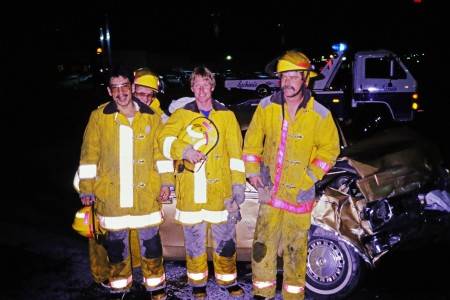SHOCK GENERAL
ALL LEVELS
DESIGNATION OF CONDITION
Signs and symptoms may include any or all of the following: disoriented, weak, tachycardia, systolic < 90, weak or absent radial pulses, cool and clammy skin, diaphoresis, pallor, nausea and vomiting, rapid and shallow respirations. For traumatic shock refer to appropriate trauma sections.
EMPHASIS ON PATIENT CARE
Maintain adequate perfusion, oxygenation
1. Primary Management - Assess ABC’s and manage as indicated.
a. Apply oxygen to keep SpO2 >94%
b. Monitor EtCO2
2. Transport the patient without delay to an appropriate medical facility.
3. Secondary Management - History, physical exam, vital signs
a. Obtain history of incident including:
i. Possible underlying medical causes
ii. Blunt or penetrating trauma refer to trauma section
AEMT
1. In-route, initiate two large bore IVs of an isotonic solution and infuse at a flow rate to maintain adequate end organ perfusion.
2. Consider treatment for possible underlying, reversible etiologies including volume depletion, tension pneumothorax, pericardial tamponade, spinal shock, and sepsis within appropriate scope of practice.
PARAMEDIC
1. Monitor cardiac rhythm and vital Signs closely
2. Obtain 12 lead ECG.
3. If no improvement with fluid bolus, or if fluids are contraindicated because of pulmonary edema administer a vasopressor.
1. NOREPHINEPHRINE (Levophed) drip @ 2-10 mcg/min IV infusion
a. Solution: 1 mg in 250 ml NS (4 mcg/ml);; dose may be titrated to patient response
2. EPINEPHRINE DRIP @ 2-10 mcg/min IV infusion
a. Administer an Epinephrine drip (2 mg of 1:1000 Epinephrine in 250 ml of NS) and start the drip of 2 ug/min (15 gtts/min). Titrate up to 10 ug/min or until an acceptable perfusing heart rate and BP are achieved. A second IV line is desired, however, do not withhold medication if second IV is unobtainable.
2. NOREPHINEPHRINE PUSH-DOSE Inject 4 mg. of Norepinephrine into 250 ml bag. Draw out 10 ml. in a syringe. Administer 0.5 ml. every minute. One advantage of this concentration is it can be transitioned to a drip as needed.
3. EPI PUSH-DOSE Inject 1 mg. (1 ml.) of Epinephrine 1:1,000 into a 100 ml. bag of NS and mix well. Withdraw 10 ml. giving a concentration of 1:100,000. Push 0.5 ml (5 mcg) every minute prn hypotension.
ALL LEVELS
DESIGNATION OF CONDITION
Signs and symptoms may include any or all of the following: disoriented, weak, tachycardia, systolic < 90, weak or absent radial pulses, cool and clammy skin, diaphoresis, pallor, nausea and vomiting, rapid and shallow respirations. For traumatic shock refer to appropriate trauma sections.
EMPHASIS ON PATIENT CARE
Maintain adequate perfusion, oxygenation
1. Primary Management - Assess ABC’s and manage as indicated.
a. Apply oxygen to keep SpO2 >94%
b. Monitor EtCO2
2. Transport the patient without delay to an appropriate medical facility.
3. Secondary Management - History, physical exam, vital signs
a. Obtain history of incident including:
i. Possible underlying medical causes
ii. Blunt or penetrating trauma refer to trauma section
AEMT
1. In-route, initiate two large bore IVs of an isotonic solution and infuse at a flow rate to maintain adequate end organ perfusion.
2. Consider treatment for possible underlying, reversible etiologies including volume depletion, tension pneumothorax, pericardial tamponade, spinal shock, and sepsis within appropriate scope of practice.
PARAMEDIC
1. Monitor cardiac rhythm and vital Signs closely
2. Obtain 12 lead ECG.
3. If no improvement with fluid bolus, or if fluids are contraindicated because of pulmonary edema administer a vasopressor.
1. NOREPHINEPHRINE (Levophed) drip @ 2-10 mcg/min IV infusion
a. Solution: 1 mg in 250 ml NS (4 mcg/ml);; dose may be titrated to patient response
2. EPINEPHRINE DRIP @ 2-10 mcg/min IV infusion
a. Administer an Epinephrine drip (2 mg of 1:1000 Epinephrine in 250 ml of NS) and start the drip of 2 ug/min (15 gtts/min). Titrate up to 10 ug/min or until an acceptable perfusing heart rate and BP are achieved. A second IV line is desired, however, do not withhold medication if second IV is unobtainable.
2. NOREPHINEPHRINE PUSH-DOSE Inject 4 mg. of Norepinephrine into 250 ml bag. Draw out 10 ml. in a syringe. Administer 0.5 ml. every minute. One advantage of this concentration is it can be transitioned to a drip as needed.
3. EPI PUSH-DOSE Inject 1 mg. (1 ml.) of Epinephrine 1:1,000 into a 100 ml. bag of NS and mix well. Withdraw 10 ml. giving a concentration of 1:100,000. Push 0.5 ml (5 mcg) every minute prn hypotension.
